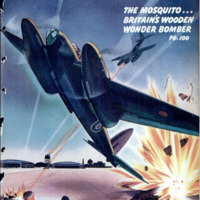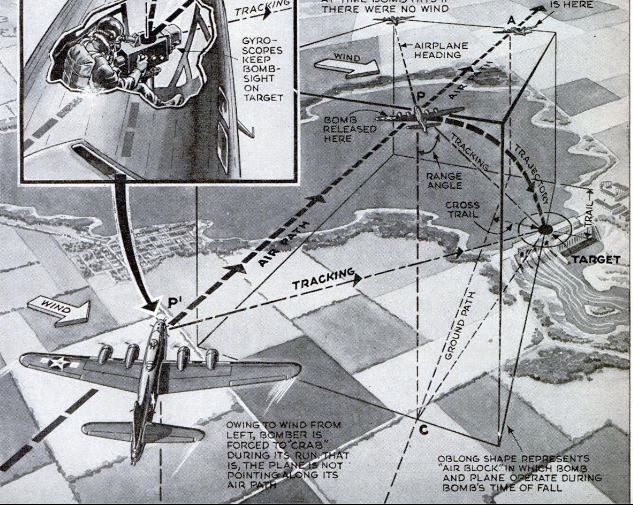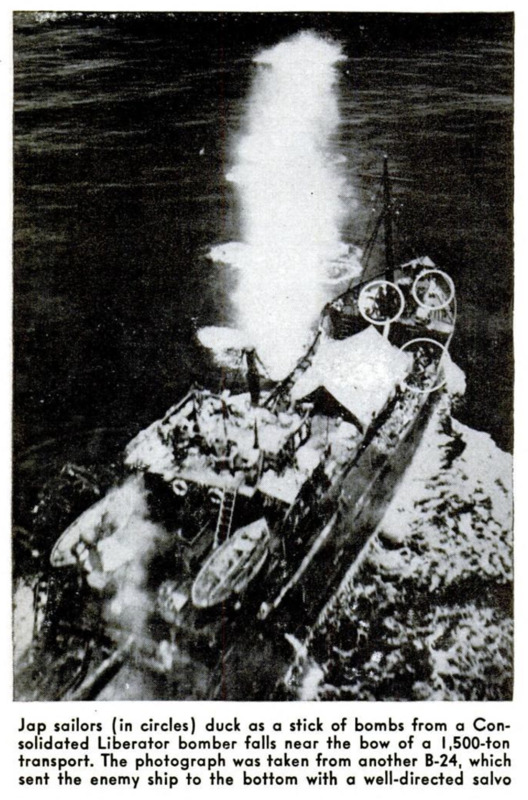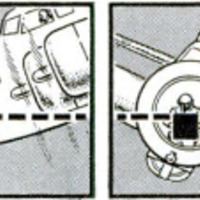-
Title (Dublin Core)
-
The Geometries of War
-
Article Title and/or Image Caption (Dublin Core)
-
Bombsight Solves Problems. Geometry and Ballistics Give It Its Deadly Accuracy
-
extracted text (Extract Text)
-
HOW does it happen that an American
bombardier, crouching in the Plexiglas
nose of a Flying Fortress or Liberator
traveling above 200 miles an hour four or
five miles above the earth, can drop a bomb
with unerring precision on an enemy power
house or moving train? The answer lies in
precision bombing—a miracle of this war.
It is a miracle of mechanics and of human
ingenuity, involving long research and ex-
periment in such fields as higher mathe-
matics, ballistics, electrical engineering,
aeronautics, and optics. But the problem of
how to bomb ground objectives precisely
from high altitudes has been solved by
American engineers to an extent not ap-
proached in any other country. It has been
solved by the constant improvement of
bombsights throughout the last decade; by
the creation of automatic pilots and fire-
control devices; and by the training of men
to use these machines.
Three basic problems had to be solved be-
fore precision bombing became a practical
method of warfare. One was the compilation
and application of all the data needed to plot
a falling bomb's trajectory. One was the
stabilization of the line of sight, or the bom-
bardier’s aim, from .a speeding, unstable
platform. The third was the development of
an automatic fire-control, or release, mech-
anism to take the inevitable margin of
human error, as far as possible, out of the
bombardier's operations and guide the bomb
exactly to the target.
Consider the factors involved in these
problems. The first and most obvious is that
the bombs trajectory has to be plotted from
a sky platform traveling too fast for human
computations of firing data, subject to move-
ments upward, downward, and sideways, as
well as forward; rolling and pitching like
a ship at sea about three axes, two
of them horizontal and one verti-
cal.
What forces bear on the bomb's
trajectory from such a platform ?
Three major ones have to be cal-
culated accurately, before a bom-
bardier can have any idea where
his missile is going. One is inertia.
One is gravity. The third is wind
resistance. All three are working
simultaneously upon that missile,
causing the bomb to fall toward
its mark in a steepening arc.
Inertia may be considered the
first of these forces, since no ex-
plosive drives a bomb as a shel
would be fired from a cannon. It
is simply dropped from a rack.
When dropped it is traveling for-
ward just as rapidly as the plane
which it leaves. Only gradually,
as the bomb travels toward its ob-
Jective, is this forward speed cut
down, so that when it reaches the
earth it is not far behind the air-
plane from which it fell.
Gravity is carrying it down-
ward, Alr resistance is acting
upon it, lessening both its hori-
zontal velocity and the downward
acceleration due to gravity. Wind
resistance is also bearing upon it,
but this is simply a directional
heightening of air resistance.
With these three basic forces at
work on his missile, a bombardier,
or his automatic bombsight, or
both, must calculate the amount
of time it will take a bomb to fall
Gravity is carrying it down-
ward. Air resistance is acting
upon it, lessening both its hori-
zontal velocity and the downward
acceleration due to gravity. Wind
resistance is also bearing upon it,
but this is simply a directional
heightening of air resistance.
With these three basic forces at
work on his missile, a bombardier,
or his automatic bombsight, or
both, must calculate the amount
of time it will take a bomb to fall
to earth, from its point and altitude of re-
lease to its target.
How fast does a bomb travel? A free-fall
ing bomb, from a stationary platform, will
fall, theoretically, 16.1 feet per square of the
number of seconds involved in its downward
course. In 10 seconds, it will travel 16.1 times
100, or 1,610 feet. In 37 seconds it will fall
16.1 times 1,369 or 22,040.9 feet. A great
deal of high-altitude, precision bombing is
done from about this height.
Leaving the rack, the bomb is traveling
forward at the speed of the plane. If the
plane is traveling 200 miles ‘an hour, the
bomb will move forward, theoretically, 204
feet while dropping only 16.1 feet in the first
second. In the next second it will fall 48
feet, (16.1 times 4) and would still be mov-
ing forward 204 feet, were it not for air or
wind resistance.
Consider first merely the wind. A 30-
mile-an-hour wind, dead on the nose of an
airplane, slows down its ground speed, while
a 30-mile wind right on the tail accelerates
it. What the wind does to the plane, it does
to the falling bomb.
One of the functions, therefore, of the
American bombsight, which is the bombar-
dier’s mechanical brain or lightning calcula-
tor, must be that of a ground-speed meter.
It has to make corrections for the “trail,” or
1ag of the bomb, behind the airplane's speed.
In practice, data on this trail is given to the
bombardier in the form of a mathematical
table, by which he sets his sight.
Since winds, however, do not always blow
directly on the nose or tail of a speeding
bomber, but often at angles to or directly
across its ground track, the bombsight also
must be able to correct the bombardier’s aim
for this “cross trail” of a bomb falling side-
ways from the track of the plane, but in
prolongation of its axis, as well as forward
at a lessening speed and downward in con-
tinuaces adodlasatiym.
The bombardier is pitching the bomb
toward the target as a pitcher throws a
curve across home plate, but he is pitching
with plenty of mechanical aid.
No new complication sets in when the
trajectory of that bomb has to be calculated
on a moving target, such as a railroad train, |
instead of a stationary one, such as a power
house.
All the factors are the same, and they will |
be unchanged in principle regardless of the
direction of the wind or motion of the target.
Further, a combination of wind and target
ination does not complicate the basic picture
or require any new settings. After the set- |
tings for trail and time of fall, the bombsight
is concerned only with the resultant closing
speed and direction of the airplane with
respect to the target, and is not interested
in the causes of the relative motion. All the
bombardier actually has to do is to track
that moving target through the cross hairs
of his telescopic sight, and the machine
makes the necessary calculations auto-
matically. Maneuvering targets, like ships
at sea, may evade slightly the downward
path of a single sighted bomb. Pattern
bombing will take care of this.
All efforts to control the flight of a falling
bomb, so that it may be curved from bomb
rack to target over a predetermined dis-
tance in a predetermined amount of time,
will fail, of course, without mechanical
means of stabilizing the line of sight—or the
bombardier’s aim—during the few precious
seconds of the bomb run, and of stabilizing
the course of the plane as well.
The airplane, of course, no matter how
skillful its human pilot may be, is capable of
many movements, besides ts forward course,
to throw off the aim of the bombardier. It
may be bounding upward, or dropping into
a wind pocket. It may be rotating on up-
ward, sideward, or forward axes by a few
degrees. Every such degree will throw off
the accuracy of the bombardier’s aim.
A single degree of oscillation by an air-
plane, during a bombing run at 25,000 feet
altitude, will throw the bomb 425 feet from
its correctly plotted bullseye. An oscillation
of three degrees would throw the bomb 1,275
feet from its mark. U. S. airmen have found
out that their planes are apt to swing at
least three or four degrees in some direction
during a bombing run, and swings of 15 de-
grees on an axis are not uncommon.
It is under such conditions that the bomb-
sight has to be balanced, so that the aim of
the bombardier may be as independent as
possible of the swaying plane. To obtain the
necessary stabilization, American bomb-
sight inventors experimented first with
pendulums, and then went on to the use of
gyroscopes, now electrically driven. A per-
fectly driven rotor, untouched by outside
forces, will main- (Continued on page 212)
tain its axis in a fixed direction in space.
That is the principle of the gyroscope.
In precision bombing, it is not enough to
have a man and machine capable of figuring
a bomb’s trajectory, and a stabilized sight-
ing mechanism. Something has to be done
to take the margin of human error out of the
bombardier’s release of his missile. In late-
model American bombsights, there is an
electric contact made with the bomb release,
so that the dropping of the bomb may be
done automatically at the exact instant when
the angle is right. There is, of course, an
alternate means of manual release, but it is
not so accurate.
During a bomb run of 20 to 40 seconds, a
human bombardier is under terrific strain.
Probably he has had a long run to the target
area. The night before his mission he has
slept but little. Up in the transparent nose
of the bomber he is the target for enemy
fighter planes, diving into him with cannon
and machine guns blazing, while flak from
the ground batteries is bursting beneath him
or clattering like hail on the plane he rides.
So great is this strain that 25 missions have
come to be the maximum for a bombardier
in flights over German-occupied Europe.
Yet, strain or no strain, there come on
every mission those few precious seconds in
which he must set his bombsight for ac-
curate fire on selected targets. If he delays
a manual release of a bomb as much as one
fifth of a second, the bomb will be wide of
the mark. Hence the adoption of the auto-
matic bomb release.
One further device has been worked out
by America’s aeronautical engineers still
further to assure the accuracy of our bomb-
ing. It is a link between the bombsight itself
and the automatic pilot. Human pilots are
expected to bring our big bombers into the
bombing runs in tight formation, so that
maximum gun power may be brought to
bear against intercepting fighters.
For a few fleeting instants, there is no
need for the human pilot to concentrate on
data from instruments for the most trying
kind of instrument flying—holding the big
ship at constant altitude and constant
ground speed, as free from oscillations as is
humanly possible.
Two mechanisms only are flying the ship
—the bombsight itself and the automatic
pilot. Instead of turn indications being given
to a human pilot by needles on a panel, the
airplane is held closely on the reading indi-
cated by the bombsight’s directional gyro-
scopes. Through these vital seconds no
human hand is at the controls of the speed-
ing plane.
The basic philosophy of precision bombing,
as contrasted with the dumping of great
masses of high explosive across broad areas,
is very simple. It aims at a miracle in eco-
nomical and merciful warfare that is al-
most as revolutionary as the American
bombsight.
“To put an automobile out of commission,”
once remarked Gen. Edgar P. Sorenson, As-
sistant Chief of Staff for Air Intelligence in
the U.S. Army Air Forces, “you don’t have
to destroy the whole automobile. All you
have to do is to take out the rotating con-
tact in the ignition distributor. Without it,
the machine won't function.”
Similarly, he said, to destroy the capacity
of an enemy country to fight, you don't have
to destroy the whole country, or even its
armies. You knock out the heart of enemy
production capacity, a chemical plant here,
an airplane factory there, and a synthetic oil
plant somewhere else. Gradually, and not at
all spectacularly, you so disintegrate the
enemy's internal economy that he is able to
fight no more.
It is to make war cheaper in terms of
casualties and mass destruction, he said, that
precision bombing aims. Because of it, the
task of our troops invading enemy territory
is to be quicker of accomplishment, and ac-
companied by fewer losses. Because of it, we
may be able to diminish the postwar hatreds
which come to populations that have suf-
fered too grievously. Because of it, we may
have a smaller task of postwar rebuilding,
and the nations now our enemies, with whom
we some .day shall have to trade, will more
quickly get back onto a sound economic
footing.
To the technical miracle of precision
bombing, then, must be added an equal
miracle, if the technique succeeds. The bomb,
which started out as a monster of terror and
destruction, is to become an instrument of
mercy, like the surgeon's scalpel.
-
Contributor (Dublin Core)
-
Allen Raymond (writer)
-
Stewart Rouse (illustrator)
-
Language (Dublin Core)
-
eng
-
Date Issued (Dublin Core)
-
1943-12
-
pages (Bibliographic Ontology)
-
117-119, 212, 214
-
Rights (Dublin Core)
-
Public Domain (Google digitized)
-
Archived by (Dublin Core)
-
Matteo Ridolfi
-
Alberto Bordignon (Supervisor)
 Popular Science Monthly, vol. 143, n. 6, 1943
Popular Science Monthly, vol. 143, n. 6, 1943








